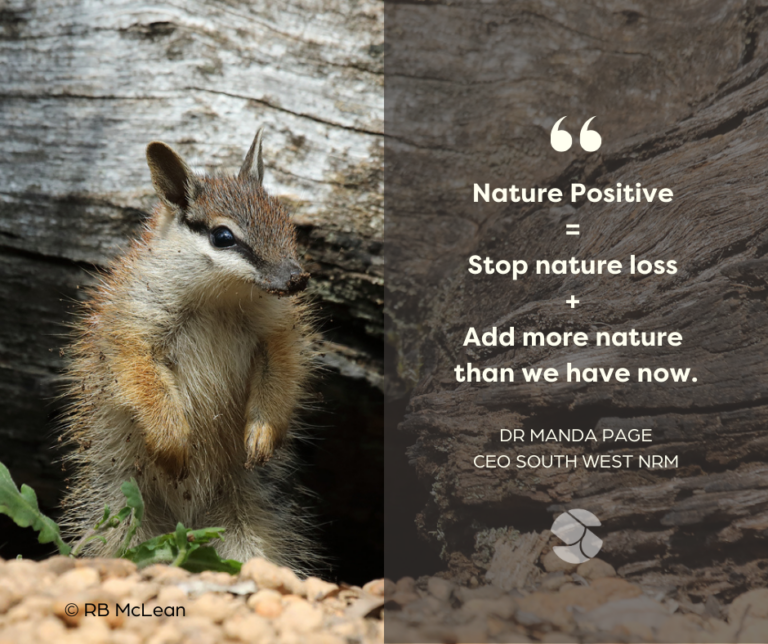
Photo by Robert McLean.
Explaining ‘Nature Positive’ by Dr Manda Page
Australia has a big problem. And attempts to both explain the problem and address it have brought forth a whole bunch of bright new buzz words (like Nature Positive) that can sometimes leave those who care about the environment, but not working in it as I have done for the past 30 years, feeling dazed and confused. Or worse: Losing interest and switching off!
Solving this problem can ONLY be achieve

d if we’re all in. So, in an attempt to not just maintain, but grow everyone’s interest in helping solve this problem, I’m having a go at sharing some simple explainers around these new buzz words.
But first, you might be wondering what this ‘problem’ that I’m referring to actually is.
It’s the gigantuous gap between environmental and climate targets Australia has set for itself (both on the national and international stage) AND the financial investment needed to get there.
The truth is we simply won’t get there if we rely on government funding alone.
And we need to get there. Biodiversity loss and ecosystem collapse is now ranked as one of the biggest threats to humanity. Not only do many of our industries rely heavily on nature but ultimately, we need it too for clean air, water, food and a liveable climate.
It’s within our move to addressing this problem where much of this new language is turning up.
Buzz words #1: Nature Positive
Perhaps the one with the MOST buzz right now. Last month I even attended the Australian Government’s Global Nature Positive Summit in Sydney – obviously named after it.
Think of it like a basic equation:
Nature Positive = Stop nature loss + Add more nature than we have now.
The concept started grabbing international headlines in 2021 when leaders at the 47th G7 Conference collectively called for the world to become net zero and nature positive. The next year commitment became more globalised when 188 countries (including Australia) collectively agreed to reverse nature loss by 2050.
This was to be achieved by protecting 30% of land, waters and seas, and restore 30% of degraded ecosystems by 2030. You might have heard it called the Kunming-Montreal Global Biodiversity Framework or the Australian Government’s policy of 30 by 30 .
Since then, Nature Positive has become somewhat of a movement embraced by governments, policy-makers, businesses and industries worldwide with acknowledgement that First Nations peoples must play a key guiding role.
In Australia, a nature positive approach underpins our national Strategy for Nature 2024-2030 which coordinates delivery on all of our international environmental obligations and targets.
Buzz words #2: Net Zero
Net Zero represents a perfect balance between greenhouse gases out versus greenhouse gases in. Or more specifically, the amount of greenhouse gas emissions released into the atmosphere through human activity and the amount taken out of the atmosphere both by reducing emissions overall and implementing methods for absorbing carbon dioxide from the atmosphere.
We have a legislated national target to reach Net Zero by 2050 and the Australian Government’s Net Zero Plan sets out our pathway to get there.
Again, this target aligns with our international obligations. As you can imagine, there are some obvious synergies here between achieving net zero and being nature positive.
In my next nuts and bolts article, I’ll attempt to dive into the emerging new language around a Nature Repair Market.
What now?
In the meantime, just remember this is new territory for everyone so try not to feel too overwhelmed by it all.
Perhaps even take some comfort in knowing that the result of all this work should be that our natural resources are more valued, protected and restored for the benefit of current and future generations.
We can all do our part by staying informed and sharing credible information within our networks. Please feel free to share this article within your circles and consider signing up to receive our monthly e-newsletter for further learnings.
For more information on environmental conservation work by South West NRM over 20 years, please visit the below page of our website.
